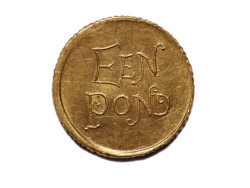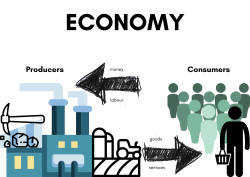NMAH and London School of Economics's collections
How did World War II affect West Africa?
<p>World War II was a global conflict affecting all regions of the world, including West Africa. Africans from British and French colonies fought all over the world in the militaries of their colonizers. When Germany invaded France in 1940, Africans in French colonies were divided between the Vichy government in West Africa and the Free French resistance in Central Africa. The currencies issued by the two separate governments illustrate this divide. </p>
 NMAH and London School of Economics
NMAH and London School of Economics
5
How did new African countries use money to show their independence?
<p>Starting in the late 1950s, African nations became independent from European colonial powers. They used their new currencies to demonstrate their sovereignty by replacing European heads of state with national leaders. The new national coins and banknotes also depicted indigenous currencies like cowrie shells in Ghana and kissi pennies in Liberia, celebrating African cultural heritage. </p>
 NMAH and London School of Economics
NMAH and London School of Economics
8
What did money look like under colonial rule in West Africa?
<p>How did colonialism affect the lives and livelihoods of Africans? The kinds of money people used can provide some clues. This collection contains coins and notes introduced by the colonial powers which Africans received in return for the sale of produce and used for paying taxes. It also includes cowrie shells, kissi pennies and manillas, which Africans often used to buy everyday goods in local markets despite colonial government policies banning them. </p>
 NMAH and London School of Economics
NMAH and London School of Economics
12
South African lesson 3: The Great Depression, the gold standard and South Africa
<p>This lesson looks at the Great Depression and the gold standard in South Africa and how these impacted the way that money worked in the country, and many other countries in the world.</p>
<p>*This lesson was developed by a South African History graduate (Amy Rommelspacher, amyrom@sun.ac.za), as part of a collaboration between Stellenbosch University, the London School of Economics and the Smithsonian with a goal of creating lesson plans for South African students using objects from the National Numismatic Collection. There are four lessons in total.</p>
<p>Find the next lesson here:</p>
<p><a href="https://learninglab.si.edu/collections/south-african-lesson-4-bretton-woods-national-currencies-and-south-africa-s-new-money/DvAXfJ1hzRn5YxpU">South African lesson 4: Bretton Woods, national currencies and South Africa's new money</a><br></p>
 NMAH and London School of Economics
NMAH and London School of Economics
14
South African lesson 4: Bretton Woods, national currencies and South Africa's new money
<p>Why do nations want their own currency?</p>
<p>We have looked at a few examples of how money has been used and how the value of money has been determined in the past.</p>
<p>In the previous lesson we looked at how money changed after WWI, and that in light of the economic destruction of the war, countries left the gold standard.</p>
<p>This lesson looks at what happened to money in South Africa after WWII and why countries around the world use different currencies.</p>
<p>*This lesson was developed by a South African History graduate (Amy Rommelspacher, amyrom@sun.ac.za), as part of a collaboration between Stellenbosch University, the London School of Economics and the Smithsonian with a goal of creating lesson plans for South African students using objects from the National Numismatic Collection. There are four lessons in total.</p>
<p>Find the other lessons here:</p>
<p><a href="https://learninglab.si.edu/collections/south-african-lesson-1-a-quick-history-of-money-what-can-money-tell-us-about-the-world/ILqb3tDWHw9Rryea">South African lesson 1: A quick history of money</a></p>
<p><a href="https://learninglab.si.edu/collections/south-african-lesson-2-minerals-and-money/3zt8IfdTrVQCvnUA">South African lesson 2: Minerals and money</a></p>
<p><a href="https://learninglab.si.edu/collections/south-african-lesson-3-the-great-depression-the-gold-standard-and-south-africa/HPZ2cJN1jRXri3mg">South African lesson 3: The Great Depression, the gold standard and South Africa</a></p>
<p></p>
 NMAH and London School of Economics
NMAH and London School of Economics
13
South African lesson 1: A quick history of money: What can money tell us about the world?
<p>In this resource, we will explore the questions: What is money? And what does it tell us about the world?</p>
<p>By looking at the history of money around the world, we will discover the different shapes and forms money can take, and think about how the history of money can help us understand the past and the present. This exercise ends with an exciting activity that gives students the opportunity to apply what they have learned by creating their own money.</p>
<p>*This lesson was developed by a South African History graduate (Amy Rommelspacher, amyrom@sun.ac.za), as part of a collaboration between Stellenbosch University, the London School of Economics and the Smithsonian with a goal of creating lesson plans for South African students using objects from the National Numismatic Collection. There are four lessons in total.</p>
<p>Find the next lessons here:</p>
<p><a href="https://learninglab.si.edu/collections/south-african-lesson-2-minerals-and-money/3zt8IfdTrVQCvnUA">South African lesson 2: Minerals and money</a><br></p>
<p><a href="https://learninglab.si.edu/collections/south-african-lesson-3-the-great-depression-the-gold-standard-and-south-africa/HPZ2cJN1jRXri3mg">South African lesson 3: The Great Depression, the gold standard and South Africa</a></p>
<p><a href="https://learninglab.si.edu/collections/south-african-lesson-4-bretton-woods-national-currencies-and-south-africa-s-new-money/DvAXfJ1hzRn5YxpU">South African lesson 4: Bretton Woods, national currencies and South Africa's new money</a></p>
<p><br></p>
<p><a href="https://learninglab.si.edu/collections/south-african-lesson-2-minerals-and-money/3zt8IfdTrVQCvnUA"><br></a></p>
<p><br><br></p>
 NMAH and London School of Economics
NMAH and London School of Economics
11




